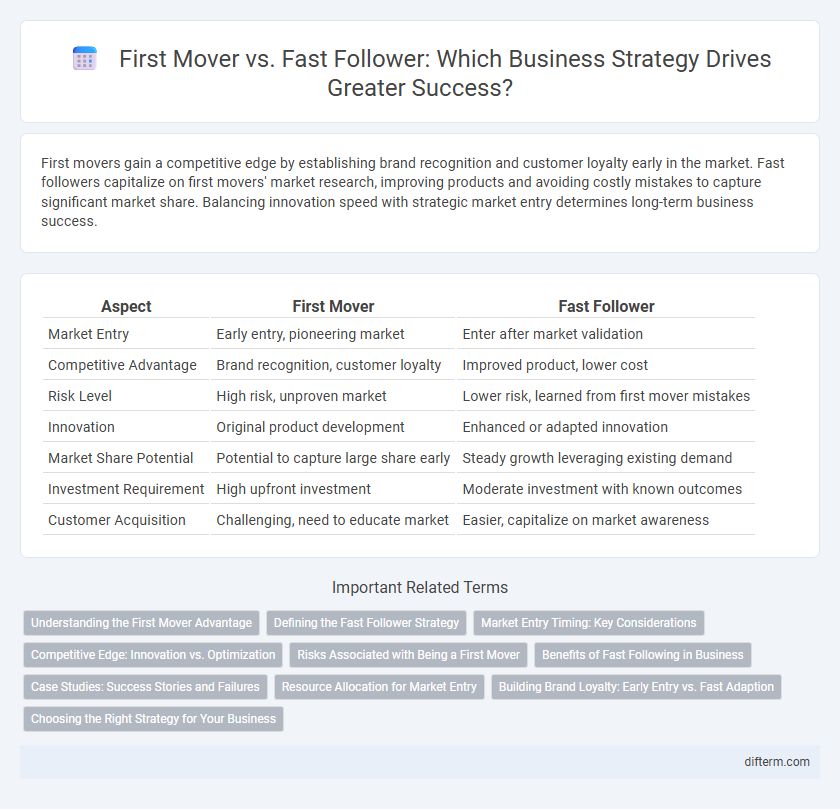First movers gain a competitive edge by establishing brand recognition and customer loyalty early in the market. Fast followers capitalize on first movers' market research, improving products and avoiding costly mistakes to capture significant market share. Balancing innovation speed with strategic market entry determines long-term business success.
Table of Comparison
| Aspect | First Mover | Fast Follower |
|---|---|---|
| Market Entry | Early entry, pioneering market | Enter after market validation |
| Competitive Advantage | Brand recognition, customer loyalty | Improved product, lower cost |
| Risk Level | High risk, unproven market | Lower risk, learned from first mover mistakes |
| Innovation | Original product development | Enhanced or adapted innovation |
| Market Share Potential | Potential to capture large share early | Steady growth leveraging existing demand |
| Investment Requirement | High upfront investment | Moderate investment with known outcomes |
| Customer Acquisition | Challenging, need to educate market | Easier, capitalize on market awareness |
Understanding the First Mover Advantage
First movers gain significant advantages by establishing strong brand recognition and customer loyalty before competitors enter the market. They can secure critical resources, set industry standards, and create high entry barriers, which fast followers may struggle to overcome. However, first mover advantage requires substantial investment and risk, as market uncertainties and potential technology obsolescence can diminish initial gains.
Defining the Fast Follower Strategy
The fast follower strategy involves closely monitoring market innovators to quickly replicate successful products or services with improvements, reducing risks associated with being first. Companies adopting this approach leverage existing market feedback and customer insights to refine offerings and optimize go-to-market timing. By capitalizing on the groundwork laid by first movers, fast followers can achieve competitive advantage through efficient resource allocation and accelerated adoption cycles.
Market Entry Timing: Key Considerations
Market entry timing critically impacts competitive advantage, with first movers benefiting from brand establishment and customer loyalty but facing higher risks and costs associated with innovation and market education. Fast followers leverage the insights gained by pioneers, allowing for improved products and more efficient market strategies, often resulting in faster scalability and reduced uncertainty. Strategic evaluation of industry dynamics, consumer behavior, and resource capabilities determines the optimal approach between pioneering and following.
Competitive Edge: Innovation vs. Optimization
First movers gain a competitive edge through innovation by introducing groundbreaking products and establishing strong brand recognition early in the market. Fast followers leverage optimization strategies to improve existing innovations, reduce costs, and capture market share with refined offerings. Balancing innovation with efficient execution allows companies to sustain growth and outperform competitors over time.
Risks Associated with Being a First Mover
First movers face significant risks including high research and development costs, market uncertainty, and the challenge of educating consumers about a new product or service. They also risk technological obsolescence as competitors, or fast followers, can learn from their mistakes and introduce improved versions more efficiently. The potential for these risks makes it crucial for first movers to carefully evaluate market readiness and their capacity for sustained innovation.
Benefits of Fast Following in Business
Fast followers benefit from reduced market entry risks by learning from first movers' mistakes and market feedback, enabling more strategic product development and resource allocation. They capitalize on existing demand and customer education, accelerating adoption while avoiding costly pioneering expenses in marketing and technology. This approach allows businesses to innovate incrementally, improving upon initial offerings and capturing significant market share efficiently.
Case Studies: Success Stories and Failures
First movers like Amazon revolutionized e-commerce by establishing dominant market positions early, leveraging innovation and customer loyalty to create lasting competitive advantages. Fast followers such as Facebook capitalized on first movers' mistakes by refining features and improving user experience, achieving rapid growth without the risks of pioneering new markets. Case studies from companies like Google and Friendster highlight that success depends on execution, market timing, and adaptability, where both first movers and followers can either dominate or fail spectacularly.
Resource Allocation for Market Entry
First movers often allocate substantial resources to innovation, product development, and brand establishment to secure market dominance and create high entry barriers. Fast followers strategically prioritize resource allocation toward rapid scaling, market adaptation, and competitive pricing to capitalize on first movers' learning and market validation. Efficient resource deployment in market entry enhances competitive advantage by balancing innovation investment with speed and operational agility.
Building Brand Loyalty: Early Entry vs. Fast Adaption
First movers often establish strong brand loyalty by capturing market attention and setting industry standards, creating a lasting customer base. Fast followers optimize by quickly adapting products and marketing strategies to meet evolving consumer preferences, enhancing customer retention through improved relevance and innovation. Balancing early entry with agile response is crucial for sustained brand loyalty in competitive business landscapes.
Choosing the Right Strategy for Your Business
Choosing between a first mover and fast follower strategy depends on market dynamics, innovation capacity, and risk tolerance. First movers can capitalize on brand recognition and establish customer loyalty, but face high costs and uncertainty. Fast followers leverage insights from pioneers' successes and failures to optimize products and reduce market entry risks, often capturing significant market share without the same level of investment.
First Mover vs Fast Follower Infographic

 difterm.com
difterm.com